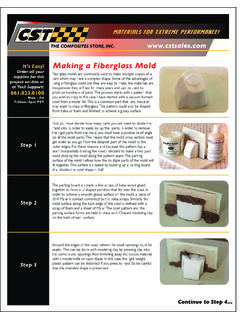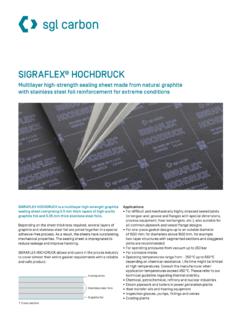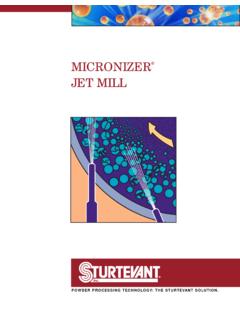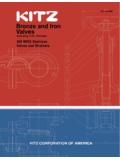Transcription of MATERIAL SAFETY DATA SHEET - Graphite Sales
1 MATERIAL SAFETY data SHEET . MSDS No.: 200. Synthetic Graphite Revision No.: 4. Date: 11/04/04. PRODUCT AND COMPANY INFORMATION SECTION 1. Graphite Sales Inc. 16710 West Park Circle Drive Manufacturer/Distributor: Chagrin Falls, Ohio 44023. 440-543-8221. Product Name: Synthetic Graphite Synonyms: Graphite Intended Use: High Temperature Applications FOR CHEMICAL EMERGENCY, SPILL, LEAK, FIRE, EXPOSURE, OR ACCIDENT: In the continental : 440-543-8221. COMPOSITION INFORMATION SECTION 2. Chemical Name: Synthetic Graphite Percent: 100. CAS Number: 7782-42-5. HAZARDS IDENTIFICATION SECTION 3. EMERGENCY OVERVIEW &. May be harmful if inhaled. May cause irritation to skin, HAZARDS PRESENT TO. eyes, and respiratory tract. Affects respiratory and MAN AND THE. cardiovascular systems. ENVIRONMENT. This MATERIAL is classified as hazardous under OSHA. REGULATORY STATUS. regulations.
2 PRIMARY ROUTES OF In dust form, inhalation is the primary route of EXPOSURE exposure. POTENTIAL HEALTH EFFECTS: In dust form, may be abrasive and irritating to the Eyes: eyes. Skin: In dust form, may cause mild irritation. If exposure limits are exceeded, the respiratory tract may become irritated. May cause shortness of breath, Inhalation: coughing and/or chest tightness due to temporary physical overloading of the lungs. Ingestion: May cause gastrointestinal disturbances. MEDICAL CONDITIONS. Persons with pre-existing respiratory impairments AGGRAVATED BY. including, emphysema and asthma. EXPOSURE: CHRONIC HEALTH EFFECTS: In dust form, may be abrasive and irritating to the eyes Eyes: through mechanical abrasion. In dust form, may be abrasive and irritating to the skin Skin: through mechanical abrasion. Page 1 of 7 THE RCS COMPANIES. MATERIAL SAFETY data SHEET .
3 MSDS No.: 200. Synthetic Graphite Revision No.: 4. Date: 11/04/04. Prolonged or repeated inhalation of dust may cause Inhalation: pulmonary fibrosis or emphysema. Possible lung cancer hazard. Ingestion: May cause nausea, vomiting, and diarrhea. FIRST AID MEASURES SECTION 4. SEEK MEDICAL ATTENTION FOR ALL CASES OF OVEREXPOSURE. FIRST AID MEASURES: Flush thoroughly with water, taking special care to rinse under the eyelids. Do not rub the eye as mechanical abrasion due to the dust Eyes: may be damaging to the cornea. If irritation persists, continue flushing for fifteen (15) minutes. If discomfort persists, seek consultation from a physician. Remove contaminated clothing. Wash irritated area thoroughly with Skin: water. Do not rub as mechanical abrasion due to the dust may prolong irritation to the skin. If overcome by dust concentrations, remove to a more ventilated Inhalation: area (fresh air).
4 Ingestion: Do not induce vomiting. Seek consultation from a physician. Instructions None recommended. for Physician: FIRE FIGHTING MEASURES SECTION 5. NFPA Classification Health Fire Reactivity Other 1 0 0 N/A. FLAMMABILITY PROPERTIES. Flash Point: N/A Method: N/A. Flammability Limits: (in air % by volume) LEL: N/A UEL: N/A. Autoignition Temperature: N/A. Hazardous Combustion Products: Products of combustion include carbon monoxide (CO), and carbon dioxide (CO2). Extinguishing Media: Use any means suitable for extinguishing surrounding fire. Prohibited Extinguishing Media: Avoid high-pressure water stream as this may spread burning powder (burning powder will float). Page 2 of 7 THE RCS COMPANIES. MATERIAL SAFETY data SHEET . MSDS No.: 200. Synthetic Graphite Revision No.: 4. Date: 11/04/04. Firefighting Instructions: In the event of a fire, wear full protective clothing and NIOSH-approved self-contained breathing apparatus with full face-piece operated in the pressure demand or other positive pressure mode.
5 Unusual Fire and Explosion Hazards: In dust form, this MATERIAL is combustible at high temperatures. Dusts may form explosive mixtures in air. MATERIAL itself burns with difficulty. ACCIDENTAL RELEASE MEASURES SECTION 6. Environmental Precautions: Spill and releases of this MATERIAL to navigable water in sufficient amounts that cause sludge or emulsion under the water must be reported immediately to the National Response Center (800/424-8802), as required by Federal Law. Contact the Coast Guard and appropriate state and local regulatory agencies. Failure to report these spills may result in substantial civil and criminal penalties. Cleanup Methods: Small spills: should be vacuumed when possible. Dry sweeping is not recommended. A. vacuum equipped with HEPA (high efficiency particulate air) filtration is recommended. If necessary, light water spray will reduce dust for dry sweeping.
6 Large spills: may be shoveled into containers. Wear appropriate personal protective equipment and respiratory protection. HANDLING & STORAGE SECTION 7. Avoid handling that will unnecessarily generate airborne dust. Handling: Graphite is a good conductor of electricity. Exercise caution when handling in areas where contact with electrical circuitry is possible. Keep in a tightly closed container, stored in a cool, dry, ventilated area. Protect against physical damage. Containers Storage: of this MATERIAL may be hazardous when empty since they retain product residues (dust, solids); observe all warnings and precautions listed for the product. Specific Uses: Users should avoid inhalation of dust. Page 3 of 7 THE RCS COMPANIES. MATERIAL SAFETY data SHEET . MSDS No.: 200. Synthetic Graphite Revision No.: 4. Date: 11/04/04. EXPOSURE CONTROLS / PERSONAL PROTECTION SECTION 8.
7 EXPOSURE CONTROLS: Exposure Limit Values: OSHA PEL: ACGIH TLV: 15 mg/m3 (Total Dust). 2 mg/m3 (for all forms Graphite (synthetic) of Graphite except 5 mg/m3 (Respirable Graphite fibers). Fraction). Engineering Controls: A system of local and/or general exhaust is recommended to keep employee exposures below the Airborne Exposure Limits. Local exhaust ventilation is generally preferred because it can control the emissions of the contaminant at its source, preventing dispersion of it into the general work area. PERSONAL PROTECTIVE EQUIPMENT: Respiratory Protection: If exposure limits are exceeded or if irritation is experienced, NIOSH approved respiratory protection should be worn. Respiratory protection may be needed for non- routine or emergency situations. Hand Protection: Appropriate chemical protective gloves should be used while handling this MATERIAL . Eye/Face Protection: Avoid eye contact with this MATERIAL .
8 Wear SAFETY glasses or chemical goggles. Provide an eyewash station in the work area. Do not wear contact lenses when working with this substance. Skin Protection: Wear impervious protective clothing, including boots, gloves, lab coat, apron or coveralls, as appropriate, to prevent skin contact. General Hygiene Considerations: Practice good industrial hygiene by washing with soap and water after each use. Avoid excessive inhalation. Other Protective Equipment: Depending upon conditions of use, additional protection may be necessary such as face shield, apron, arm-covers, etc. Page 4 of 7 THE RCS COMPANIES. MATERIAL SAFETY data SHEET . MSDS No.: 200. Synthetic Graphite Revision No.: 4. Date: 11/04/04. PHYSICAL & CHEMICAL PROPERTIES SECTION 9. PRODUCT: Synthetic Graphite General Information: Appearance Grey to black solid, may be in the form of a dust Odor Odorless Important Health, SAFETY , and Environmental Information: Boiling Point N/A.
9 Melting Point N/A. Flash Point N/A. Explosive Properties N/A. Oxidizing Properties N/A. Specific Gravity (H 2O = 1) Water Solubility Insoluble Partition Coefficient Not Determined (n-octanol/water). Viscosity N/A. Vapor Pressure (mm Hg) N/A. Vapor Density (Air = 1) N/A. Evaporation Rate N/A. % Volatile (By Volume @ 68 F) Zero STABILITY & REACTIVITY SECTION 10. Stability: This MATERIAL is stable under normal conditions. Conditions to Avoid: Incompatibilities with strong oxidizers. This condition is aggravated when the MATERIAL is heated. Materials to Avoid: Graphite reacts vigorously with liquid potassium, potassium peroxide and will ignite with chlorine trifluoride and fluorine. If Graphite contacts liquid potassium, rubidium, or caesium at 300C, intercalation compounds may be formed. These compounds may explode on contact with water or ignite in air. Hazardous Decomposition Products: Carbon monoxide, carbon dioxide.
10 Hazardous Polymerization: Polymerization will not occur with this MATERIAL . Page 5 of 7 THE RCS COMPANIES. MATERIAL SAFETY data SHEET . MSDS No.: 200. Synthetic Graphite Revision No.: 4. Date: 11/04/04. TOXICOLOGICAL INFORMATION SECTION 11. Route of Species Type of Test Effects Dose data Exposure Observed No Information Available ECOLOGICAL INFORMATION SECTION 12. Ecotoxicity: No effects are expected from this MATERIAL due its insolubility. Insolubility leads to non- bioavailability. Mobility: N/A. Persistence and Degradability: N/A. Bioaccumulative Potential: N/A. DISPOSAL CONSIDERATION SECTION 13. Treatment, storage, transportation, and disposal must be in accordance with applicable Federal, State/Provincial, and Local regulations. Do not flush to surface water or sanitary sewer system. TRANSPORT INFORMATION - SECTION 14. DOT CLASSIFICATION: UN Number: This MATERIAL is not regulated by the DOT for transportation Class: Proper Shipping Name: Packing Group: Marine Pollutant: Other Information: IATA CLASSIFICATION: UN Number: This MATERIAL is not regulated by IATA for transportation Class: Proper Shipping Name: Packing Group: Marine Pollutant: Other Information: Page 6 of 7 THE RCS COMPANIES.







